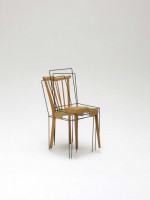JULIAN STERZ
Place Keeper Chair
source: design-milk
“I have an idea. You take any chair, with four legs and saw it into four equally-sized pieces. The resulting 1/4-chairparts will be added to four place-keeper-chairs, which lack the corresponding piece. The resulting new four complete chairs enrich themselves of the value and design of the original chair which has undergone some kind of cell division.”
So begins Julian Sterz’s ”Diploma Thesis on the Topic Place-Keeper,” an investigation into identity and archetypes. Taking arguably the most recognisable expression of design, a chair, he experiments with what makes it a chair – how much form and functionality can you take away before it ceases to be a chair?
He says: “I had the notion that it might be a charming idea in itself not to design formally on my own device. That led me to the idea to split already existing design objects including their adherent symbolic and material value and to distribute the resulting components to so called placeholder-objects who act as recipients.”
He was initially keep to use a high value chair such as a Louis XIV chair or an Eames chair, but eventually opted for a ubiquitous wooden household chair. In contrast he wanted the ‘placeholder’ to be a low grade material such as a cast reproduction of the original, cardboard or steel wire construction, opting in the end for the latter. He says: “I developed a serious interest in design-objects that are considered alongside art. These objects are ‘place holders’ because they often lack their implied usage or the ability to be mass produced. But they stand in place for a strong meaning, which to me is often even more important than the primary practical use of something.”
This is one of those projects that challenges conventions and really makes you think. Julian is still pursuing this line of investigation and, having completed this piece as an installation, hopes to develop a functional product that can be mass produced – it’ll be interesting to see where his thinking takes him.
.
.
.
.
.
.
.
source: urdesignit
During the last edition of imm Cologne, Julian Sterz presented the ‘Place Keeper Chair‘, a destructured seat that has been also mentioned at the young designers’ competition D3 Contest. The designer chose to work on an icon object, like the chair, to study and analyze it during his industrial design thesis work.
The project, a cross between an installation and a product design, is based on conceptual and formal aspects developed by the designer. “The idea was to design a chair whose six basic elements (four legs, a seat and a backrest) were joined by a further part of molded plastic,”says Julian Sterz,” During the design process I wanted to emphasize the features of the original chair through a systematic division of the parts.”
.
.
.
.
.
.
.
source: paperblogfr
Julian Sterz, jeune designer allemand nous présente sa chaise concept baptisée 3/4 Place Keeper Chair.
Il décompose sa chaise en quatre éléments ou une armature métallique vient supporter chaque découpe de la chaise d’origine en bois.
Le mot du designer :
« I had the notion not to design formally on my own device. This led me to the idea to split already existing design objects and to distribute the resulting components to so called placekeeper-objects who act as recipients. A cell division of symbolic value?«


